PORSCHE CAYNNE 2013 2.G Information Manual
Manufacturer: PORSCHE, Model Year: 2013, Model line: CAYENNE, Model: PORSCHE CAYENNE 2013 2.GPages: 79, PDF Size: 14.97 MB
Page 31 of 79
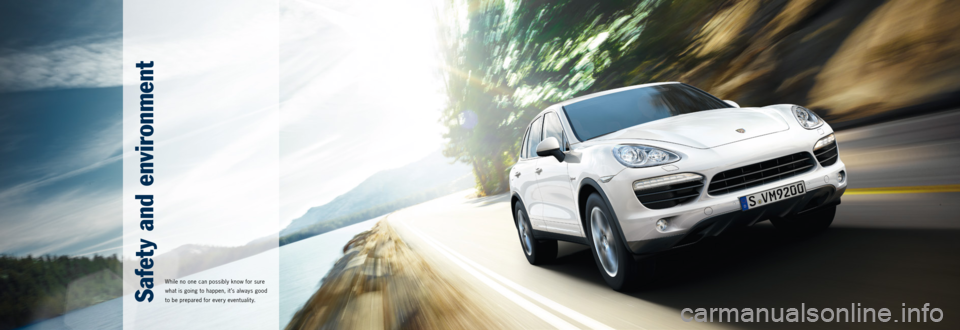
Safety and environment
While no one can possibly know for sure
what is going to happen, it ’s always good
to be prepared for every eventualit y.
Page 32 of 79
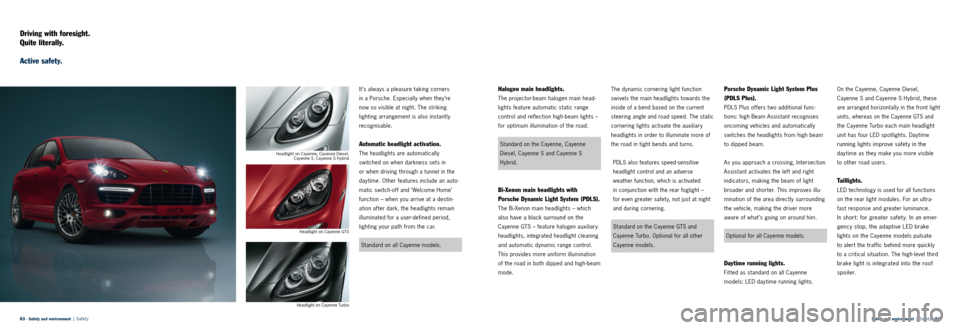
Safety and environment | Safet y · 64
63 · Safety and environment | Safet y
Driving with foresight.
Quite literally.
Active safety.
It’s always a pleasure taking corners
in a Porsche. Especially when they’re
now so visible at night. The striking
lighting arrangement is also instantly
recognisable.
Automatic headlight activation.
The headlights are automatically
switched on when darkness sets in
or when driving through a tunnel in the
daytime. Other features include an auto -
matic switch-off and ‘Welcome Home’
function – when you arrive at a destin -
ation after dark, the headlights remain
illuminated for a user-defined period,
lighting your path from the car.
Standard on all Cayenne models.
Halogen main headlights.
The projector-beam halogen main head -
lights feature automatic static range
control and reflection high-beam lights –
for optimum illumination of the road.
Standard on the Cayenne, Cayenne
Diesel, Cayenne S and Cayenne S
Hybrid.
Bi-Xenon main headlights with
Porsche Dynamic Light System (PDLS).
The Bi-Xenon main headlights – which
also have a black surround on the
Cayenne GTS – feature halogen auxiliary
headlights, integrated headlight cleaning
and automatic dynamic range control.
This provides more uniform illumination
of the road in both dipped and high-beam
mode. The dynamic cornering light function
swivels the main headlights towards the
inside of a bend based on the current
steering angle and road speed. The static
cornering lights activate the auxiliary
headlights in order to illuminate more of
the road in tight bends and turns.
PDLS also features speed-sensitive
headlight control and an adverse
weather function, which is activated
in conjunction with the rear foglight –
for even greater safet y, not just at night
and during cornering.
Standard on the Cayenne GTS and
Cayenne Turbo. Optional for all other
Cayenne models.
Porsche Dynamic Light System Plus
(PDLS Plus).
PDLS Plus offers t wo additional func -
tions: high Beam Assistant recognises
oncoming vehicles and automatically
switches the headlights from high beam
to dipped beam.
As you approach a crossing, Intersection
Assistant activates the left and right
indicators, making the beam of light
broader and shorter. This improves illu -
mination of the area directly surrounding
the vehicle, making the driver more
aware of what ’s going on around him.
Optional for all Cayenne models.
Daytime running lights.
Fit ted as standard on all Cayenne
models: LED day time running lights. On the Cayenne, Cayenne Diesel,
Cayenne S and Cayenne S Hybrid, these
are arranged horizontally in the front light
units, whereas on the Cayenne GTS and
the Cayenne Turbo each main
headlight
unit has four LED spotlights. Day time
running lights improve safet y in the
day time as they make you more visible
to other road users.
Taillights.
LED technology is used for all functions
on the rear light modules. For an ultra-
fast response and greater luminance.
In
short: for greater safet y. In an emer -
gency stop, the adaptive LED brake
lights on the Cayenne models pulsate
to alert the traffic behind more quickly
to a critical situation. The high-level third
brake light is integrated into the roof
s p o i l e r.
Headlight on Cayenne Turbo
Headlight on Cayenne, Cayenne Diesel,
Cayenne S, Cayenne S Hybrid
Headlight on Cayenne GTS
Page 33 of 79
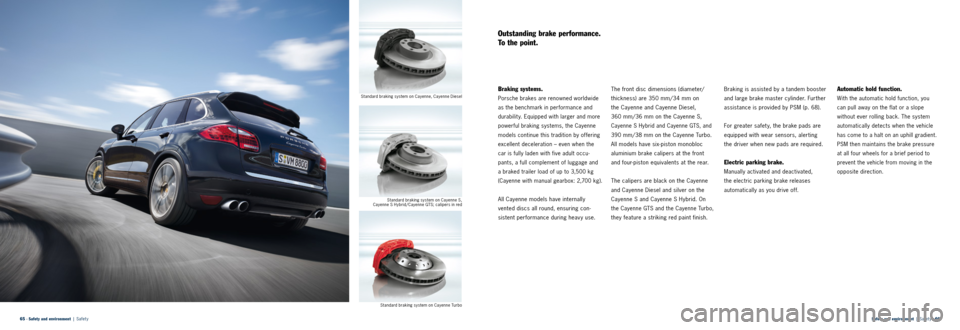
Safety and environment | Safet y · 66
65 · Safety and environment | Safet y
Outstanding brake performance.
To the point.
Braking systems.
Porsche brakes are renowned worldwide
as the benchmark in performance and
durability. Equipped with larger and more
powerful braking systems, the Cayenne
models continue this tradition by offering
excellent deceleration – even when the
car is fully laden with five adult occu -
pants, a full complement of luggage and
a braked trailer load of up to 3,500 kg
(Cayenne with manual gearbox: 2,700 kg).
All Cayenne models have internally
vented discs all round, ensuring con -
sistent performance during heav y use. The front disc dimensions (diameter/
thickness) are 350 mm/34 mm on
the Cayenne and Cayenne Diesel,
360 mm/36 mm on the Cayenne S,
Cayenne S Hybrid and Cayenne GTS, and
390 mm/38 mm on the Cayenne Turbo.
All models have
six-piston monobloc
aluminium brake calipers at the front
and four-piston equivalents at the rear.
The calipers are black on the Cayenne
and Cayenne Diesel and silver on the
Cayenne S and Cayenne S Hybrid. On
the Cayenne GTS and the Cayenne Turbo,
they feature a striking red paint finish.
Standard braking system on Cayenne Turbo Standard braking system on Cayenne S,
Cayenne S Hybrid/Cayenne GTS; calipers in red
Standard braking system on Cayenne, Cayenne Diesel
Braking is assisted by a tandem booster
and large brake master cylinder. Further
assistance is provided by PSM (p. 68).
For greater safet y, the brake pads are
equipped with wear sensors, alerting
the driver when new pads are required.
Electric parking brake.
Manually activated and deactivated,
the electric parking brake releases
automatically as you drive off.
Automatic hold function.
With the automatic hold function, you
can pull away on the flat or a slope
without ever rolling back. The system
automatically detects when the vehicle
has come to a halt on an uphill gradient.
PSM then maintains the brake pressure
at all four wheels for a brief period to
prevent the vehicle from moving in the
opposite direction.
Page 34 of 79

Safety and environment | Safet y · 68
67 · Safety and environment | Safet y
Recuperation.
The electronic engine management sys -
tem on the Cayenne S Hybrid controls
the braking process so that, when
the brake pedal is actuated, as much
expended energy as possible can be
harnessed by the electric machine in gen-
erator mode and stored in the 288-volt
nickel metal hydride (NiMH) bat tery. This
is referred to as recuperation. To do this,
the engine management system adjusts
the generator current depending on the
brake pedal position, recovers part of
the kinetic energy and stores it in the
bat tery. When the pressure on the brake
pedal exceeds a certain threshold, the
brakes are applied.
Porsche Ceramic Composite Brake
(PCCB).
Available as an option on all Cayenne
models, the Porsche Ceramic Composite
Brake (PCCB) has already proven its
abilit y to cope with the harshest require -
ments of the racetrack. It is available in
conjunction with 20-inch wheels or larger
for the Cayenne Turbo and with 19-inch
wheels or larger for all other Cayenne
models.
The discs are made from a specially
treated carbon-fibre compound that is
silicated in a high-vacuum process at
approximately 1,700 °C. The resulting
material is not only much harder than
cast iron, it is also more resistant to
heat.
Even at high temperatures, the thermal
resistance of the PCCB disc ensures
outstanding dimensional stability. The
ceramic material is totally resistant to
corrosion and offers excellent acoustic
damping properties.
PCCB enables shorter braking distances
– no mat ter how tough the driving
conditions. The pedal response is fast
and precise with only moderate input
required. Excellent fade resistance
ensures greater balance when slowing
from high speed.
The key advantage of PCCB is a total
weight saving of approximately 50
%
compared with equivalent cast-iron discs.
As well as enhancing performance and fuel economy, the unsprung and rotating
masses are lightened. The results:
greater comfort and road-holding on
uneven road surfaces plus better
handling and agility.
Optional for all Cayenne models.
Porsche Ceramic Composite Brake (PCCB)For fuel consumption, CO2 emissions and efficiency class data, please refer to pages 150/151.
Page 35 of 79

Safety and environment | Safet y · 70
69 · Safety and environment | Safet y
Porsche Stability Management (PSM).
Porsche Stabilit y Management (PSM) is
an electronic control system that uses a
range of functions – including anti-lock
braking (ABS) – to help stabilise the
vehicle (and trailer, if fit ted) in hazardous
road scenarios. Throughout each journey,
sensors monitor the direction, speed,
yaw velocit y and lateral acceleration of
the car. Using this information, it is pos-
sible to calculate the actual direction of
travel at any given moment. If the car
begins to oversteer or understeer, PSM
applies selective braking on individual
wheels to restore stabilit y. If necessary,
PSM can also intervene in the engine
management system to temporarily
modify the amount of drive transmitted
to the wheels. PSM has three additional functions that
help reduce braking distances. If the
throt tle pedal is released suddenly, PSM
automatically readies the braking sys
-
tem. The pressure in the brake lines
is marginally increased, bringing each
of the pads into light contact with the
corresponding disc. If the driver goes on
to apply the brakes, the calipers respond
more quickly and the braking distance is
reduced.
In an emergency stop – i.e. when the
pressure on the brake pedal exceeds
a certain threshold – the brake assist
function uses the PSM hydraulics to
apply maximum braking force at all
four wheels.
Preparing for the road ahead.
With a little help from PSM.
For added safet y, the system also read -
ies the brakes whenever a decreasing
distance to the vehicle in front is detect -
ed. The optional adaptive cruise control
and PSM interact to prefill the brakes.
Even if adaptive cruise control is inactive,
the system registers the speed of the
vehicle in front and automatically readies
the braking system. In addition, the sys -
tem alerts the driver to the decreasing
distance by briefly tugging on the
brakes.
PSM also features a trailer stabilisation
function – for a significant contribution
to car and trailer safet y. Within the laws
of physics, it compensates for load
transfer caused by throt tle and brake inputs up to the maximum degree of
lateral acceleration. It also enhances the
car’s driving dynamics and directional
stability when accelerating on inconsis
-
tent road surfaces.
Other features include a special control
strategy in the ABS for braking on loose
surfaces. By briefly locking the wheels,
a wedge is formed ahead of each t yre
which provides additional purchase to
help slow the car, e.g. on gravel or snow.
For a more involving driving experience,
PSM can also be disabled, but remains
active in the background.
Standard on all Cayenne models.
Page 36 of 79
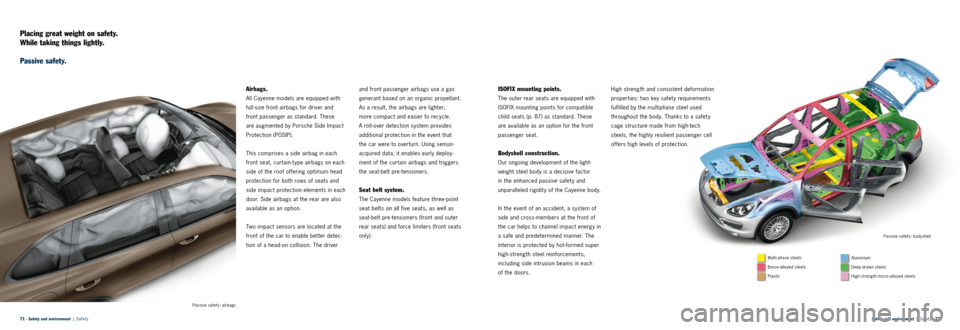
Safety and environment | Safet y · 72
71 · Safety and environment | Safet y
Placing great weight on safety.
While taking things lightly.
Passive safety.
Airbags.
All Cayenne models are equipped with
full-size front airbags for driver and
front passenger as standard. These
are augmented by Porsche Side Impact
Protection (POSIP).
This comprises a side airbag in each
front seat, curtain-t ype airbags on each
side of the roof offering optimum head
protection for both rows of seats and
side impact protection elements in each
door. Side airbags at the rear are also
available as an option.
Two impact sensors are located at the
front of the car to enable bet ter detec -
tion of a head- on collision. The driver and front passenger airbags use a gas
generant based on an organic propellant.
As a result, the airbags are lighter,
more compact and easier to recycle.
A roll-over detection system provides
additional protection in the event that
the car were to overturn. Using sensor-
acquired data, it enables early deploy-
ment of the curtain airbags and triggers
the seat-belt pre-tensioners.
Seat belt system.
The Cayenne models feature three-point
seat belts on all five seats, as well as
seat-belt pre-tensioners (front and outer
rear seats) and force limiters (front seats
only).
ISOFIX mounting points.
The outer rear seats are equipped with
ISOFIX mounting points for compatible
child seats (p. 87) as standard. These
are available as an option for the front
passenger seat.
Bodyshell construction.
Our ongoing development of the light -
weight steel body is a decisive factor
in the enhanced passive safet y and
unparalleled rigidit y of the Cayenne body.
In the event of an accident, a system of
side and cross-members at the front of
the car helps to channel impact energy in
a safe and predetermined manner. The
interior is protected by hot-formed super
high-strength steel reinforcements,
including side intrusion beams in each
of the doors.
Passive safety: bodyshell
Passive safet y: airbags
High strength and consistent deformation
properties: t wo key safet y requirements
fulfilled by the multiphase steel used
throughout the body. Thanks to a safet y
cage structure made from high-tech
steels, the highly resilient passenger cell
offers high levels of protection.
Multi-phase steels
Boron-alloyed steels
Plastic Aluminium
Deep-drawn steels
High-strength micro-alloyed steels
Page 37 of 79

Safety and environment | Environment · 74
73 · Safety and environment | Environment
The concept behind every car we build
is based around the pursuit of perform -
ance. This has been the case since
1948. Another of our traditional core
values is efficiency. At Porsche, we are
continually striving to find a successful
balance between the two.
This is achieved using advanced engine
concepts featuring technologies such
as DFI (p. 40), VarioCam Plus (p. 39),
the auto start /stop function (p. 38),
the parallel full hybrid drive (p. 28) and
consistent lightweight construction. Weight reduction is a key aspect of our
design philosophy derived from our rich
racing heritage. Part of our R&D Centre,
the Motorsport Department is located in
Weissach where it shares premises with
the Automotive Industry Exhaust Emission
Centre (ADA). Just a
coincidence? We call
it symbiosis.
In practice: the Cayenne is up to 185 kg
lighter, depending on the model.
1) We
have achieved this through the use of
new, innovative weight-saving materials,
the development of new production technologies and functionalities, and a
series of concept modifications. This
has enabled us to halve the weight of
the tailgate, for example. Innovative
materials are also a feature of the axle
construction, with steel being replaced
where possible by lightweight alterna -
tives such as aluminium and plastic.
The benefits for the driver: greater agilit y
and driving dynamics – with lower fuel
consumption. Efficiency at its best.
Great achievements are something to be proud of.
Even more so if they benefit the world around you.
Environment.
1) Compared to previous model.For fuel consumption, CO2 emissions and efficiency class data, please refer to pages 150/151.
Page 38 of 79

Safety and environment | Environment · 76
75 · Safety and environment | Environment
Exhaust emissions.
The Cayenne models are all equipped
with the latest emissions technology. As
a result, they comply with the European
exhaust emissions standard, EU 5.
Whatever the class, every Porsche
combines high performance with com -
paratively moderate emissions. On the
Cayenne models, this is achieved using
advanced drive concepts – from petrol
and diesel engines to our parallel full
hybrid drive. This is further aided by the
rapid warm-up cycle of the catalytic
converters. The optimum operating tem -
perature is reached earlier so emissions
are reduced sooner when starting from
cold. On the petrol- engined and hybrid models,
another important feature is the use of
t win oxygen-sensor circuits. Each bank of
cylinders has a separate control system
which the engine management system
uses to establish the optimum amount of
fuel – for effective emissions control.
The exhaust-gas recirculation on the
Cayenne Diesel routes part of the exhaust
gas back into the combustion process,
resulting in lower peak com bustion tem-
perature and therefore lower nitrogen
oxide emissions. An oxidation catalyst
also forms an integral part of the process
along with a diesel particulate filter.
Porsche engines.
Performing for today – and the future.
Fuel and fuel economy.
Increasing performance while enhancing
fuel economy. The Cayenne comes in a
choice of three different drive systems,
each featuring state-of-the-art technol -
ogy for high efficiency and relatively low
fuel consumption. The petrol-engined
models already operate on fuels with
an ethanol content of up to 10 %. This
further improves the carbon dioxide
balance since the plants grown for the
production of biofuels absorb carbon
dioxide from the atmosphere. As you
can see, for the benefit of the environ
-
ment, we are continually working on
making our cars more efficient – as
well as compatible with alternative
fuels. While ensuring that they remain
one thing: a thoroughbred Porsche.
Fuel system.
We have also applied the highest stand -
ards to our petrol- engined models in
order to protect the environment from
fuel evaporation. The non-return fuel
supply system provides a considerable
reduction in vapour emissions. The lines
carrying vapour are made from multi-
layer plastics. A large active-carbon
filter and multi-layer plastic fuel tank help
reduce evaporation still further.
For fuel consumption, CO
2 emissions and efficiency class data, please refer to pages
15 0/ 151.
Page 39 of 79
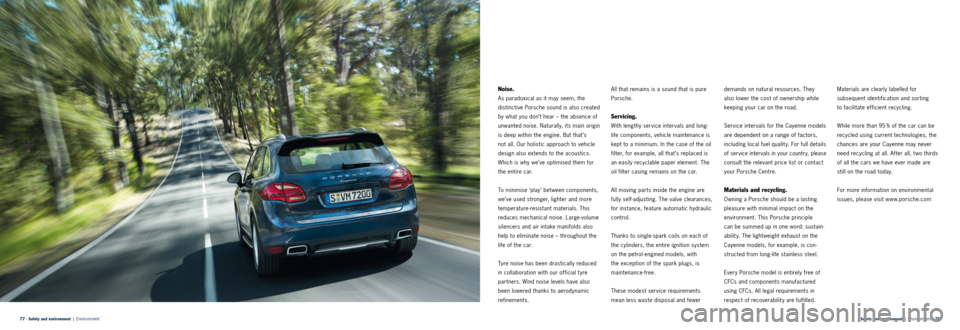
Safety and environment | Environment · 78
77 · Safety and environment | Environment
Noise.
As paradoxical as it may seem, the
distinctive Porsche sound is also created
by what you don’t hear – the absence of
unwanted noise. Naturally, its main origin
is deep within the engine. But that ’s
not all. Our holistic approach to vehicle
design also extends to the acoustics.
Which is why we’ve optimised them for
the entire car.
To minimise ‘play’ between components,
we’ve used stronger, lighter and more
temperature-resistant materials. This
reduces mechanical noise. Large-volume
silencers and air intake manifolds also
help to eliminate noise – throughout the
life of the car.
Tyre noise has been drastically reduced
in collaboration with our official t yre
partners. Wind noise levels have also
been lowered thanks to aerodynamic
refinements. All that remains is a sound that is pure
Porsche.
Servicing.
With lengthy service intervals and long-
life components, vehicle maintenance is
kept to a minimum. In the case of the oil
filter, for example, all that ’s replaced is
an easily recyclable paper element. The
oil filter casing remains on the car.
All moving parts inside the engine are
fully self-adjusting. The valve clearances,
for instance, feature automatic hydraulic
control.
Thanks to single-spark coils on each of
the cylinders, the entire ignition system
on the petrol-engined models, with
the exception of the spark plugs, is
maintenance-free.
These modest service requirements
mean less waste disposal and fewer demands on natural resources. They
also lower the cost of ownership while
keeping your car on the road.
Service intervals for the Cayenne models
are dependent on a range of factors,
including local fuel quality. For full details
of service intervals in your country, please
consult the relevant price list or contact
your Porsche Centre.
Materials and recycling.
Owning a Porsche should be a lasting
pleasure with minimal impact on the
environment. This Porsche principle
can be summed up in one word: sustain -
abilit y. The light weight exhaust on the
Cayenne models, for example, is con -
structed from long-life stainless steel.
Every Porsche model is entirely free of
CFCs and components manufactured
using CFCs. All legal requirements in
respect of recoverability are fulfilled.
Materials are clearly labelled for
subsequent identification and sorting
to facilitate efficient recycling.
While more than 95 % of the car can be
recycled using current technologies, the
chances are your Cayenne may never
need
recycling at all. After all, t wo thirds
of all the cars we have ever made are
still on the road today.
For more information on environmental
issues, please visit www.porsche.com
Page 40 of 79
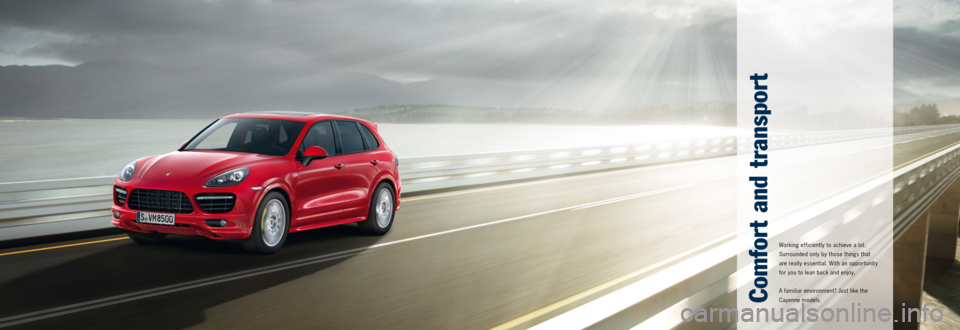
Working efficiently to achieve a lot.
Surrounded only by those things that
are really essential. With an opportunit y
for you to lean back and enjoy.
A familiar environment? Just like the
Cayenne models.
Comfort and transport